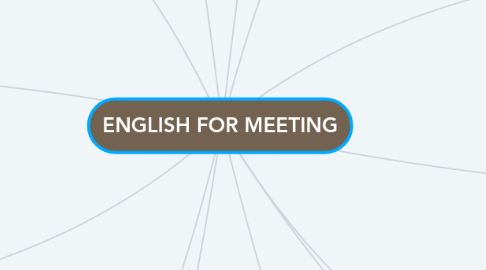ENGLISH FOR MEETING
by Amirul Aiman

1. 8.MAKING DECISIONS
1.1. More discussion
1.2. Referring to time
1.3. Closing the discussion
1.4. Focusing
1.5. Establishing consensus
1.6. Voting
1.7. Confirming
1.8. Deferring
1.9. Moving on
2. 9.CLOSING A MEETING
2.1. Completing the agenda
2.2. Summarizing
2.3. Delaying Decision
2.4. Everything is clear
2.5. Final questions
2.6. Confirm new responsibilities
2.7. Next meeting
2.8. Closing the meeting
3. 10. PROBLEM-SOLVING MEEETINGS
3.1. What is the problem
3.1.1. We are facing a problem with.. We need to look at the question of.. In this meeting I would like to raise the problem of.. A problem with...has risen.
3.2. Cause
3.2.1. The problem was caused by The problem was a result of
3.3. Solving problems-action plan verbs
3.4. Future problems?
4. 11.VOCABULARY BUILDING
4.1. A. Suggestion
4.2. B. Decision
4.3. C. Plan
4.4. D. Objective
4.5. E. Agenda
4.6. F. Opinion
5. 12. MEETINGS AT A GLANCE
5.1. Introduction - the chair
5.2. The discussion
5.3. Ending - the chair
6. 13. CROSS-CULTURAL TIPS
6.1. Preparation
6.2. Structure
6.3. Roles
6.4. Language and communication
6.5. Time
6.6. Decision-making
6.7. Non-verbal aspects
7. 1. WHAT MAKES A GOOD MEETING
7.1. Preparation-a checklist
7.1.1. Time&place
7.1.2. People
7.1.3. Roles
7.1.4. Purpose
7.1.5. Type of meeting
7.1.6. Facilities
7.1.7. Communication
7.2. Execution
7.3. Effective chairing
7.4. Effective participating
8. 2. MEETINGS : KEY TERMS
8.1. The process
8.2. Communication: verbs and nouns
8.3. Arrangement
9. 3. OPENING A MEETING
9.1. Starting
9.2. Welcoming and introducing
9.3. Apologies for absence
9.4. Defining the objective
9.5. Introducing the agenda
9.6. The minutes
9.7. Process and roles
9.8. Length of meeting
9.9. Let's begin
10. 4. GIVING AND RESPONDING TO OPINIONS
10.1. Asking for opnions
10.2. Involving people
10.3. Recommending
10.4. Comments to support and focus
11. 5.CONTROLLING
11.1. Active listening : responding to motivate
11.2. Active listening : reformulating to clarify
11.3. Moving off the point
11.4. Keeping to the agenda
11.5. Reffering foward
11.6. Reffering back
11.7. Postponing
11.8. Length of meeting
11.9. Confirming a decision
11.10. Closing and moving on
12. 6. INTERRUPTIONS
12.1. Chair - Interrupting
12.2. Chair - Stopping an interruption
12.3. Participants - interrupting
12.4. Participants - stopping an interruption
12.5. Why did you interrupt
12.6. Reffering to others opinions
12.7. Changing the focus of the discussion
12.8. Commenting on an interruption
12.9. Chair - exploiting an interruption
13. 7. ASKING QUESTIONS
13.1. Check questions - we want to make sure people understand
13.2. Development questions - we want more information
13.3. You need clarification
13.4. You need to hear a second time
13.5. You are listening
13.6. Open questions
13.7. Closed questions
13.8. Leading questions
13.9. Factual questions


